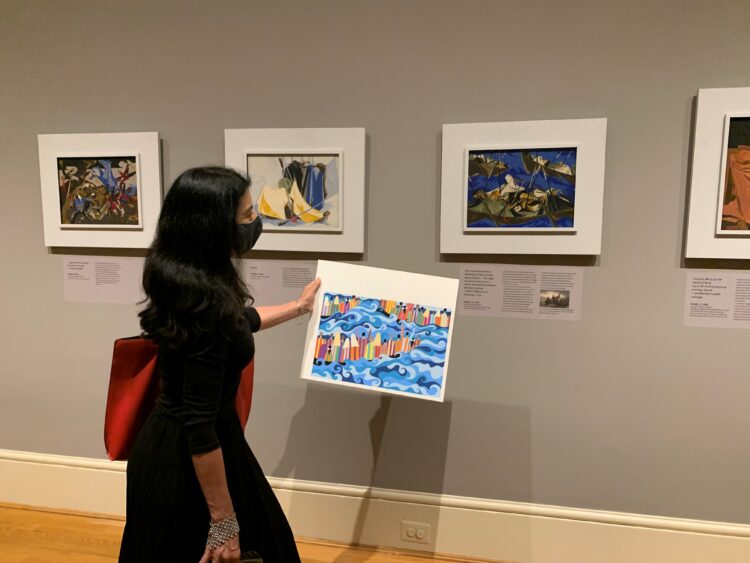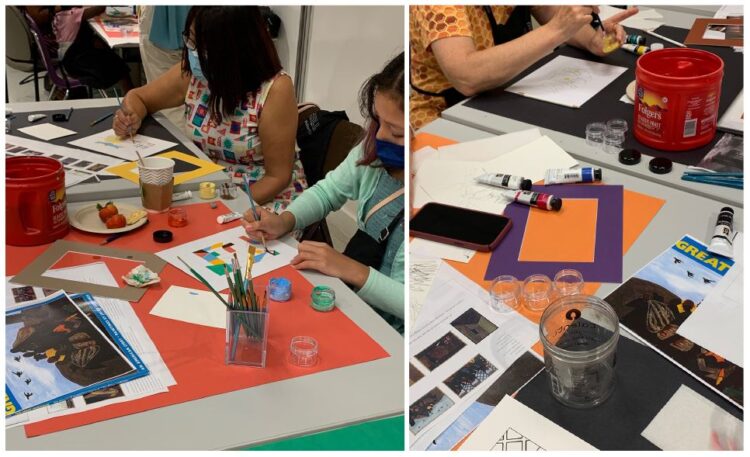Artist Helen Zughaib shares how she used Jacob Lawrence’s painting materials and style to lead a workshop at the Phillips.
A few weeks ago, I hosted my second workshop at the Phillips, using the masterful paintings of Jacob Lawrence, specifically his Migration Series and Struggle: From the History of the American People, as inspiration. In close examination of his work, one can distill the composition, color, and pattern to translate his method of painting to a group of enthusiastic participants.

Helen Zughaib leading a discussion about Jacob Lawrence’s Struggle series
My own method of working, simplifying and flattening shapes and figures into a two-dimensional composition, echoes Lawrence’s style—and I am very proud of that! After some discussion through the galleries, we suggested that our participants select a panel from the Migration Series or Struggle series, and for them to use their own story to create a new painting.
For our workshop we used gouache, an opaque watercolor, which is what I primarily use in my paintings. Rather than canvas, I use illustration board. The thickness of the board prevents buckling or warping, as the paint is quite heavy.
Gouache dries very quickly, so I have learned after many years to move briskly as I work in order to keep the brushstrokes flat and smooth. I use gouache because I like the opacity it affords and I feel like I can control the paint. The gouache I use comes in tubes which I mix to make my own colors. I learned this technique at university in art school, and since then I have practiced using it over the many years following my BFA. It is not an easy paint to use as it dries quickly and is not forgiving if you make a mistake. Lots of artists do not like it for that reason. I feel I have mastered it to accomplish what I want in my painting. Using very small amounts of water, getting the right consistency with the paint—not too thin and watery and not too thick—is a trick that takes awhile to get the hang of. I also need to mix the correct amount of paint, as it is difficult to mix a new batch that matches my previous color. I use a cold press surface board that holds the paint well and does not buckle under the weight of the gouache. I use pencil first to get my approximate composition, then fine tune my drawing in ink, then finally apply the gouache.
Jacob Lawrence also used gouache as well as egg tempera, which is made of powdered pigments mixed with egg yolk, or egg white, or casein, which all serve to hold the pigments together. Tempera paint also dries very quickly and has a bit of a sheen to it. One advantage of egg tempera is that you do not need to cover the piece with glass to protect your completed work, while with gouache, you do need that layer of protection.

Participants in Zughaib’s workshop working in gouache
At the end of our workshop, we spoke about the new paintings the participants had created, and the inspiration behind them as well as their personal narrative. We all learned from one another as we shared our work and listened to the stories behind them.
How would you use Jacob Lawrence’s artworks as inspiration? How does Lawrence’s use of flat colors add to the story he is telling? Have you tried paring down your painting into color and shape to help distill your ideas? Would you prefer to use gouache like a transparent watercolor or do you like the opacity of the gouache as I use in my paintings?
